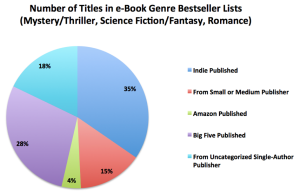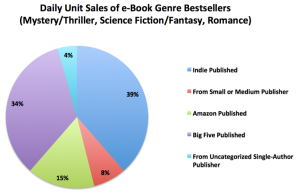How to Publish a Novel: Self vs. Traditional
Key Differences Between Self and Traditional Publishing
Overview
Self-publishing and traditional publishing possess many differences between them, but here are the primary ones:
- How much time it takes to publish
- The amount of money paid to the author
- Degree of creative control
- How the book will be distributed
- Public perception of the book
Read on for elaboration on each of these points.
Time
Let’s assume you are an author that has just signed a contract with a traditional publishing company. Though the company may have accepted your work, actually turning your manuscript into a proper book takes a very long time, sometimes years [4]. This long time interval results from several factors: [5]
- Editing and rewrites at the behest of the publisher
- Cover design
- Marketing and release to critics
- Printing
- Distribution to bookstores
- Marketing to the book’s target demographic
In contrast, self-publishing services typically allow authors to publish (electronically at least) with the push of a button [2, 4].
Money
As mentioned in the respective tutorials for each publishing method, royalties differ drastically between the two services, usually hovering around 15% for traditional publishing and 70% for self-publishing[1, 3]. However, royalties are far from the only financial difference between the two.
Traditional publishers offer their authors an advance payment as part of the initial contact [1]. For first time authors, this payment usually varies between $1,000 and $10,000 [1]. In some contracts, authors must recoup their advance payment in royalties before earning additional income from book sales [1].
In exchange for higher royalties, self-published authors receive less financial aid from their publishing agencies [2, 3, 4]. Self-publishing agencies do not provide advance payments, and the author must pay for any marketing or editing costs he or she wishes to provide for the book [3, 4]. Additionally, if an author wishes to distribute physical copies of a self-published book via a bookstore, the bookstore typically takes 40-50% of the royalties, if the bookstore even agrees to stock it at all [4].
Creative Control
As a self-published author, you own all rights to your work and have full creative control over it [2, 3, 4]. You decide your genre, word count, writing style, characters, all editing aspects, and publish the book fully on your terms [2, 3, 4].
Conversely, as a traditionally published author, your publisher may wish to implement serious changes to your work in order to maximize both quality and potential profit [4]. While the publisher is unlikely to suggest completely rewriting your entire work (though that does happen in some occasions), some changes will inevitably be mandatory, changes that you might disagree with [4]. Remember that traditional publishers provide editors primarily to improve upon what already exists, not to entirely replace your work with something more marketable [5].
Distribution
In traditional publishing, distribution lies largely in the hands of the publishing company in question [5]. The company determines how many physical copies of the book the publisher feels it can reasonably sell, and takes charge of printing and distributing copies to bookstores, along with providing electronic variants on the appropriate websites [1]. Should the work prove successful, the publisher will inevitably print more [1].
Self-published works gravitate strongly toward the ebook market, as most self-published authors lack the funding and marketing abilities of traditional publishers within the printed realm [2]. Which electronic marketplace (Kindle, iTunes, etc.) a self-published work reaches depends on the self-publishing service you use [2].
Public Perception
Audiences as a whole tend to favor traditional publishing over self-publishing [2, 4]. Bookstores prioritize placement of traditionally published books over self-published ones, as do most critics when writing book reviews [2]. This favor stems from self-publishing’s DIY nature and lack of quality control for its manuscripts [2]. As such, self-published books tend to sell much less copies than their traditional counterparts [2].
Next week’s post will cover the pros and cons between self and traditional publishing.
Signing off,
Daniel Franjac
Sources
[1]. Brandewyne, R. (n.d.). Advances & Royalites — How Authors Are Paid. Retrieved from http://www.brandewyne.com/writingtips/authorspaid.html
[2]. Carnoy, D. (2012, June 13). Self-publishing a book: 25 things you need to know. Retrieved from http://www.cnet.com/news/self-publishing-a-book-25-things-you-need-to-know/
[3]. Lamont, I. (2014, July 25). How to Self-Publish a Book. Retrieved from http://lifehacker.com/how-to-self-publish-your-own-book-1610916214
[4]. Morrissey, S. (2014, November 16). Self-publishing vs. traditional publishing: How to choose? Retrieved from http://www.miamiherald.com/news/business/biz-monday/article3950085.html
[5]. Traditional Publishing. (n.d.). Retrieved from http://www.preparedtopublish.com/what-is-publishing/traditional-publishing/

